Mastiha: The Challenging Harvest that Keeps Chios Alive
From family traditions to modern innovation,...

The Hora of Serifos: Perched on a rock, it is a classic example of a Cycladic settlement. Its narrow alleyways are accessible only on foot.
© Angelos Giotopoulos
Oliver first visited Serifos in 1988 during a trip through the Cyclades. He has never fully left. Returning to the island several times, he eventually purchased a home in Hora, and in recent years, he has divided his time between Serifos and the United Kingdom. Nikos and Demosthenes grew up in Athens, but about ten years ago, they chose to return to their native Serifos and produce honey on its northern slopes. Others, such as Natasha, arrived to the island as visitors without having any roots or past connections. During the economic crisis, she left Athens, moved to Serifos, and started a new career by following her passion for ceramics, which she currently manufactures and sells in her shop.
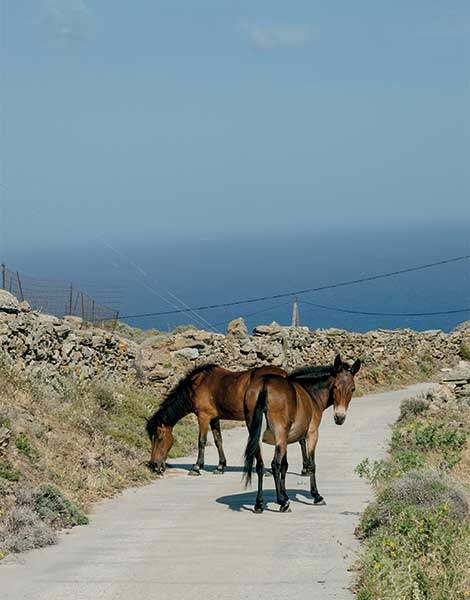
Horses against the rocky landscape, a characteristic image of a Serifos summer.
© Angelos Giotopoulos
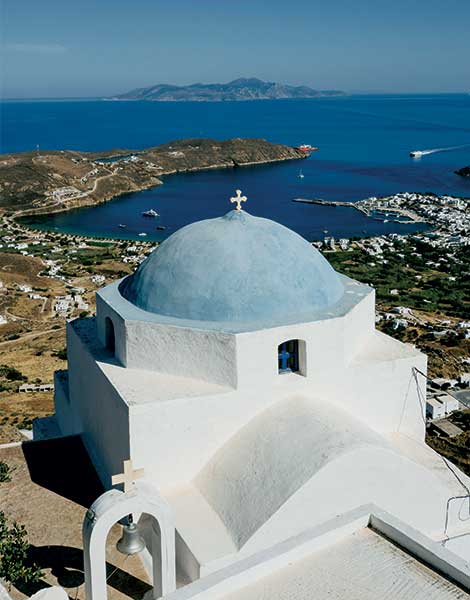
The Livadi as seen from the Hora.
© Angelos Giotopoulos
On this island in the Western Cyclades, you’ll get to hear many anecdotes like these, particularly if you visit in the early spring or early autumn when people are more laid back and getting ready for the season. Houses are whitewashed, new shops set up chairs and tables, and roads are being paved. May and September provide a nostalgic view of the Cyclades, seemingly unchanged over time. This is exactly what Nikos and Nikoleta tell us while we talk in an alley in Hora. They visited Serifos last August and recall having to deal with the crowds. During their recent journey in May, they discovered a new island, one they could actually appreciate.
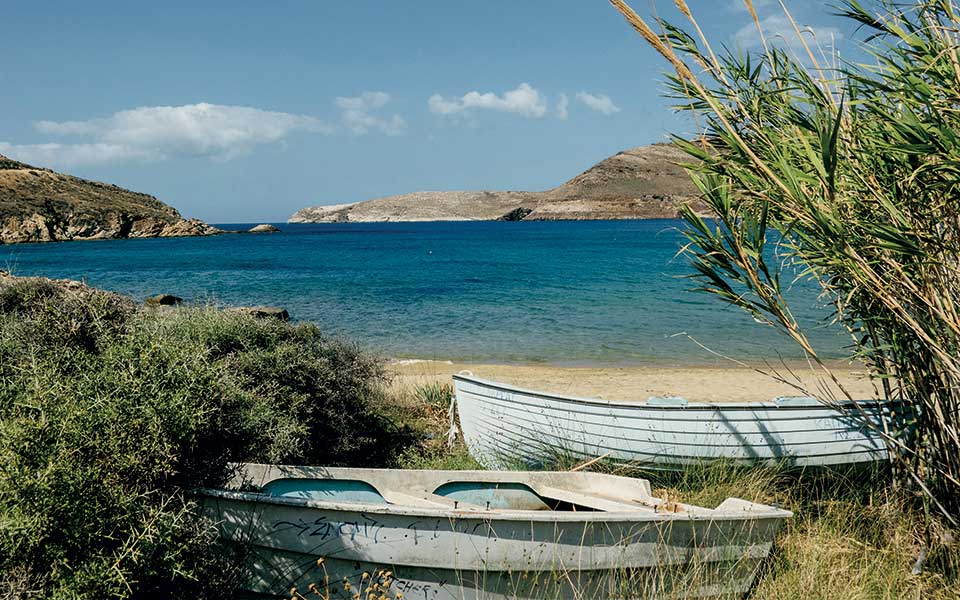
Ganema Beach
© Angelos Giotopoulos
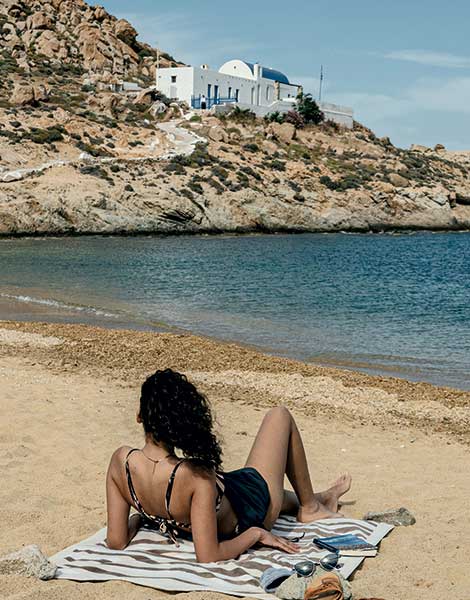
Aghios Sostis Beach
© Angelos Giotopoulos
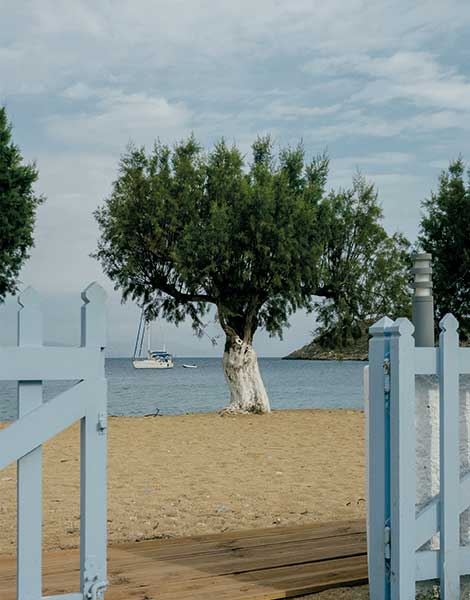
Livadakia Beach
© Angelos Giotopoulos
Serifos attracts less visitors than other Cycladic islands, and its landscape has not been as heavily altered by developent as elsewhere. While the rugged, arid slopes in the south have seen an increase in construction, many places remain pristine. The same applies to its more than 70 beaches. Only two or three have shops or hotels nearby, but they are located further back, not right on the sand.
The only umbrellas and sunbeds one sees are those brought by visitors. Ganema, Psili Ammos, Vagia, Aghios Sostis, Karavi, and Livadakia are some of Serifos’ most well-known beaches, each with golden sand and tamarisk trees. Many others may require a bit of walking or driving on dirt roads, but they are well worth the effort during the peak tourist season. Maliadiko, like Kalogeros, requires a hike. To reach Kalo Ampeli, you’ll need to walk for about 20 minutes, and the same goes for Skala in the northern part of the island.
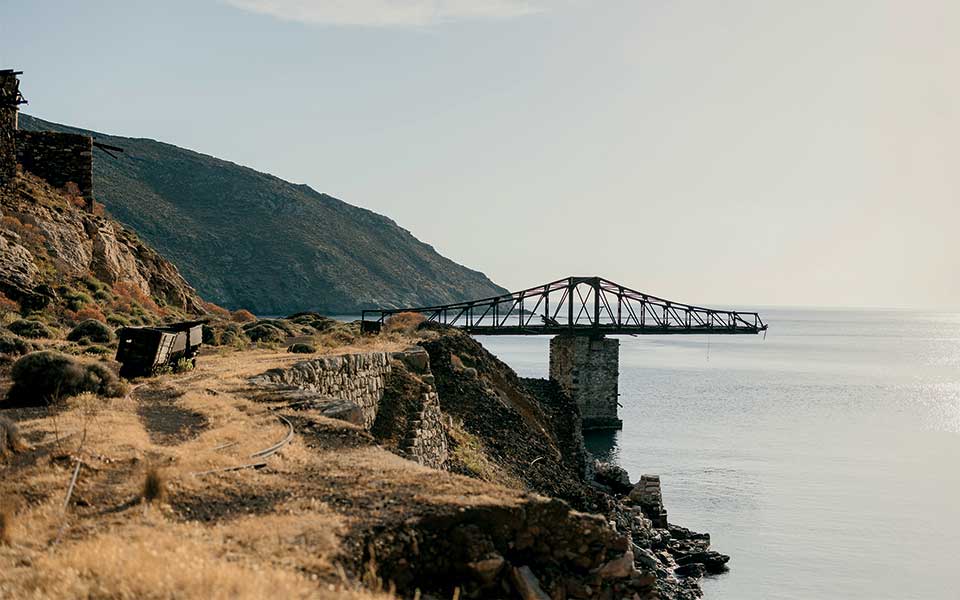
The loading bridge at Megalo Livadi: This monument of the island's mining history is in urgent need of maintenance.
© Angelos Giotopoulos
Serifos’ mines have had a significant impact on its history. The first strikes in support of an eight-hour workday in Greece occurred here in 1916, and nearly every permanent resident has a story about an ancestor who worked hard in the tunnels. The mines began operations in 1869, principally for the extraction of iron, and closed in 1963. Since then, wagons, tunnels, loading bridges, and machinery have been left to the elements. As you drive around, you’ll notice the holes in the mountains, the installations at Koutalas, and the bridge at Megalo Livadi, which is now facing structural and erosion issues.
The residents’ association wasted no time. Together with the Laboratory of Local and Island Development of the University of the Aegean, the Urban Environment Laboratory of the National Technical University of Athens (NTUA), and the Hellenic Section of the International Committee for the Conservation of Industrial Heritage, they submitted a dossier to the international program “World Monuments Watch,” aiming to include the area of Megalo Livadi and Koutalas in the World Monuments Watch 2025 as an endangered monument site. Additionally, NTUA is studying the safety, access, and management conditions of the mining sites and facilities.
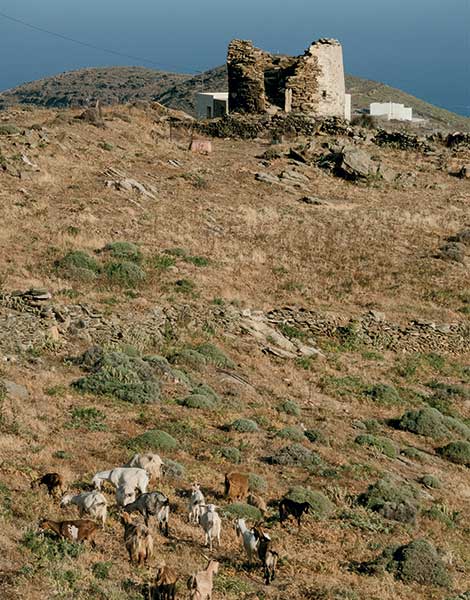
Goats on the rugged slopes of the island’s north side.
© Angelos Giotopoulos
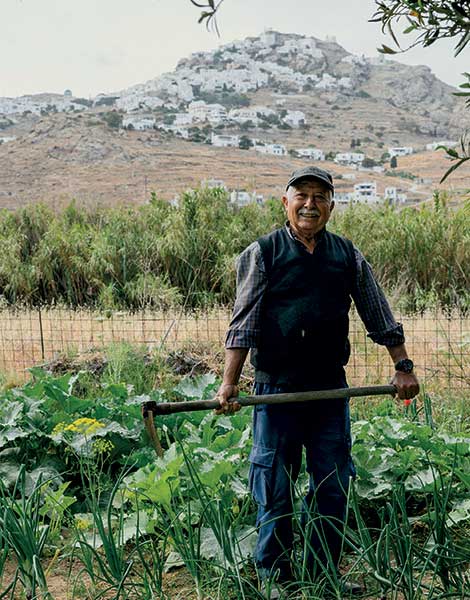
Some people persist in cultivating their arid gardens on the island.
© Angelos Giotopoulos
Traditional occupations are also in danger of disappearing, as fishermen Angelos and Vasilis are quick to point out. They are among the few traditional fishermen left on the island, and they tell us that fishing is a difficult job that requires sacrifices that younger people are unwilling to make.
The Hellenic Society for the Environment and Cultural Heritage shared the same goal of raising awareness about cultural heritage and the importance of balanced tourism development that takes into account profit, local quality of life, and environmental conservation. Following an application to Europa Nostra, three Cycladic islands—Sifnos, Folegandros, and Serifos—were added to the organization’s list of the seven most endangered monuments and cultural heritage sites in Europe for the year 2024. The announcement highlights, among other things, the “mountainous and rugged terrain that contributes to their unique character.”
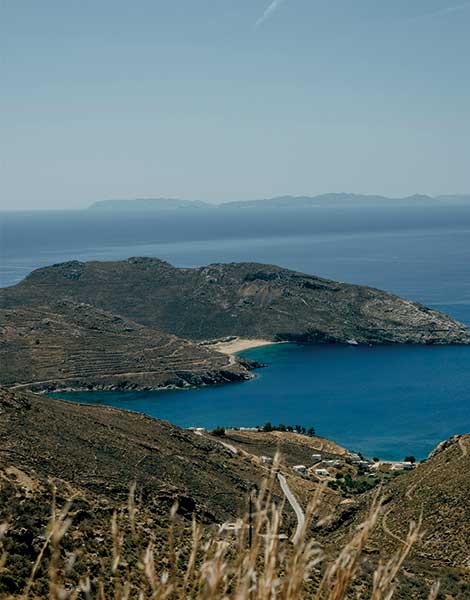
View of Vagia on the island’s south side.
© Angelos Giotopoulos
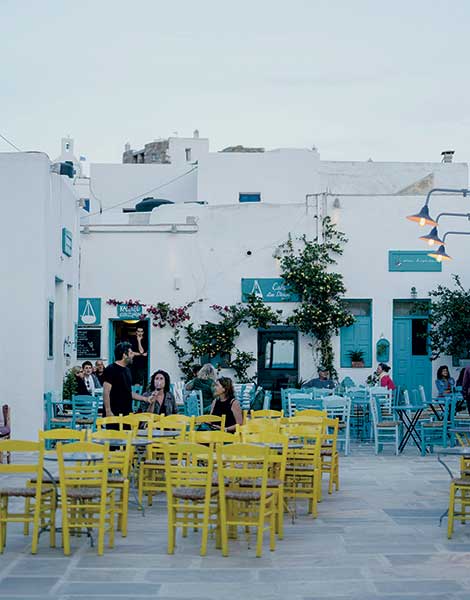
Stou Stratou
© Angelos Giotopoulos
Serifos stands out from other islands for its sharp contrast between intelligent architecture and rugged nature. The island is barren and arid, with steep slopes above its beaches, and the sole road that encircles it shows its dramatic landscape to great effect—from the golden sandy beaches and abandoned mines in the southwest to the dry-stone walls that surround the little northern hamlet of Panagia.
The most iconic sight, however, is Hora, perched precipitously on a rock above Livadi’s port. Vehicles are not allowed in its narrow alleyways, which are a perfect example of Cycladic architecture. The compact, cubical, single-story homes are designed to suit the needs of a family without the appearance of riches or luxury. Serifos’ residents have historically built their homes close together, with thick walls and small windows, for protection against pirates and strong winds. While pirates are no longer a threat, the fierce Meltemi winds that blow through the Aegean in the summer persist. Unfortunately, in recent years, newer buildings constructed outside of traditional settlements and planning zones have disregarded this age-old wisdom, ignoring the island’s physical and climatic reality.
However, Hora’s buildings continue to withstand the winds, embodying the timeless stories of the Cycladic islands. These are stories about people who came to Serifos and fell in love with the island’s enduring gifts: the sun, the sea, and the ruggedly beautiful landscape that is dotted with the whitewashed dwellings of the scattered villages.
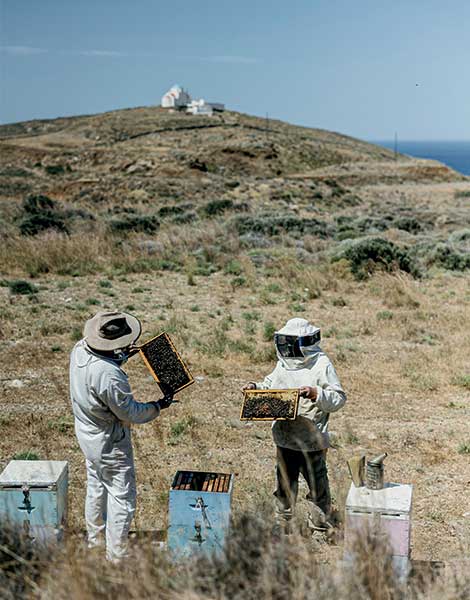
Demosthenes Diamantis moved from Athens to Serifos to produce honey from wild lavender and thyme on the island’s slopes.
© Angelos Giotopoulos
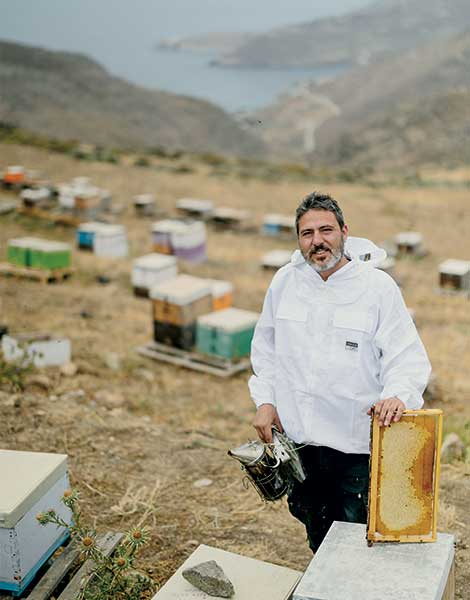
Frygana
© Angelos Giotopoulos
Serifos is well-known for its superb organic honey, which is produced without large-scale intensive farming. The island’s bees collect nectar from wild lavender and thyme, resulting in a fragrant and distinctive honey. The island’s cooperative honey processing facility ensures quality through rigorous testing and analysis in collaboration with the Aristotle University of Thessaloniki. Two prominent young beekeepers on Serifos are Demosthenes Diamantis (Melissona Diamanti) and Nikos Kokolakis (Frygana). Their honey is available in supermarkets throughout the island as well as select retailers in Athens.
Natasha Kalogeropoulou creates a variety of ceramics at Kerameio (Hora, Tel. (+30) 22810.516.69) using high-temperature clay fired at 1,240 degrees Celsius, ensuring that all of her creations are safe to use. Her shop carries a diverse and stylish variety of plates, cups, vases, lamps, and earrings.
Serifos is one of the Cycladic islands nearest to Attica. The fast boat from Piraeus takes around 2 hours (63.50 euros per person one way), while the standard ferry takes about 4 hours (from 39 euros per person one way). Daily routes are available throughout the summer.
Indigo (Livadi, Tel. (+30) 22810.525.48, from 130 euros for a double room) offers double rooms and apartments with all amenities and balconies near the sea and busy shops.
Vassilia (Livadakia, Tel. (+30) 22810.519.03, from 110 euros for a double room) is perfect for families and groups, with houses or apartments that can easily accommodate four people.
Chill & Co (Livadi, Tel. (+30) 698.234.8797, from 100 euros for a double room) offers modern and elegant rooms located on the seafront and near the port.
Aliktypo (Livadi, Tel. (+30) 22810.510.00, from 75 euros for a double room) offers reasonably priced double rooms, studios, and maisonettes. The maisonettes can accommodate up to five people.
Nautilus (Livadakia, Tel. (+30) 694.807.7972, from 100 euros for a double room) offers modern rooms and suites with white hardwood ceilings and full amenities.
The boutique hotel Nostos (Livadi, Tel. (+30) 22810.516.77, double rooms start at 80 euros) offers simple, minimalist, and contemporary rooms. Many of the rooms feature balconies with sea views.
If you’re on the northern beaches, Nikolias (Platys Gialos, Tel. (+30) 22810.521.74) is a great option for fresh fish and seafood while looking out at the sea. The tavern also serves a variety of handcrafted appetizers and fresh salads.
Bakakaki (Livadi, Tel. (+30) 22810.510.10) has become a favorite among meat lovers. It is famous for its hearty pork chops and delicious burgers, as well as Armenian pastrami pies, well-prepared bougiourdi, and saganaki with kavourma.
You can relax for hours at Fragosykos (Livadi, Tel. (+30) 22810.520.40). They serve good coffee, breakfast, and delicious pinsa (thin-crust pizza). In the evening, try one of their signature cocktails.
At the beautiful balcony of Aloni Tavern with a view of Livadi (on the route from Livadi to Hora, Tel. (+30) 22810.526.03), you can taste traditional Greek dishes such as lemony lamb with potatoes in the oven and baked chickpeas, as well as grilled meats such as lamb chops and kontosouvli.
Above the beach of Psili Ammos, Stefanakos (Tel. (+30) 694.459.4188) serves coffee, beer, and food all day, including seafood, cooked dishes, and hearty salads.
Indigo (Livadi, Tel. (+30) 22810.519.56) is open from early in the morning for breakfast and coffee until late at night for beer and light snacks. The tables by the sea are an oasis of coolness when there’s a breeze.
Scoop (Livadi, Tel. (+30) 22810.525.00) serves coffee to go before heading to the beaches, and you may return in the evening for ice cream and loukoumades.
The Yacht Club (Livadi, Tel. (+30) 22810.518.88) is a popular nightlife destination on Serifos. Located by the sea, it offers wonderful alternative summer music and is open from the morning for coffee and food. In the evening, it serves cocktails and beers from small breweries.
In Hora’s main square, you can grab one of the colorful tables at Stou Stratou (Tel. (+30) 22810.525.66). It is busy from early in the morning for coffee and breakfast until late for tsipouro, beer, and meze.
When night falls, Gaidaros (Hora) is a must-visit for expertly crafted cocktails and a great view from the rooftop.
From family traditions to modern innovation,...
Discover Greece’s islands in September with...
Patmos Aktis, Resort & Spa combines...
There’s something about Samos in summer...